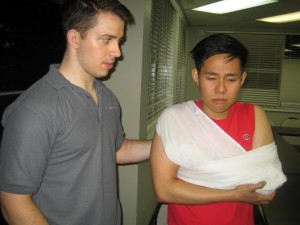Fact Checked
Take Care Of Wounds First
- The most serious injuries when emergencies take place are wounds. These are open injuries that result in blood loss.
- It is vital that these wounds are seen to first. Wounds that are open can bring microorganisms into the body, causing infection.
- Wounds must be rinsed and bandaged as quickly as possible to avoid extra blood loss and the possibility for infection.
Look For Support
- Once you have dealt with open wounds, you should then look for any broken bones. Supporting a broken or fractured bone helps to reduce the pain and guards the area from further damage.
- It is vital to find something firm that will hold up the bone. Search for a piece of wood, some sticks, or firmly rolled papers. Clothes can also be used to hold up the bone if nothing else is available.
- Medical adhesive tape can be used to tightly tie the broken arm to avoid unnecessary movement.
It is crucial for the healing of a broken arm that the bone is does not budge. To keep the area steady, the splint must be extended further than the injury
Expand The Splint
- It is crucial for the healing of a broken arm that the bone does not budge.
- To keep the area steady, the splint must be extended further than the injury. For instance, the splint should be placed beneath and above the broken arm to offer complete support.
- Don’t make the splint too heavy beneath the injury. This will result in more pressure being placed on the broken bone, aggravating the situation.
Avoid Making It Too Tight
- The splint should be attached securely to keep it steady and protected. It should not, however, be fixed too tightly.
- Don’t tie knots near to the broken bone. Creating a splint that is too loose-fitting can result in too much movement.
- A splint that is too rigid, however, could stop blood flow to the area, resulting in severe damage.
Deal With Shock
- Shock can be extremely hazardous in the result of an emergency. It is significant to guard the casualty against shock.
- Use blankets or any extra clothes so the casualty is kept warm. Make certain, however, that force is not affecting the area.
- Keep the injured casualty speaking while you wait for assistance to arrive.
- If the splint you have created is causing further pain, get rid of it quickly.
Related Video On Shock
Was this post helpful?
Let us know if you liked the post. That’s the only way we can improve.

